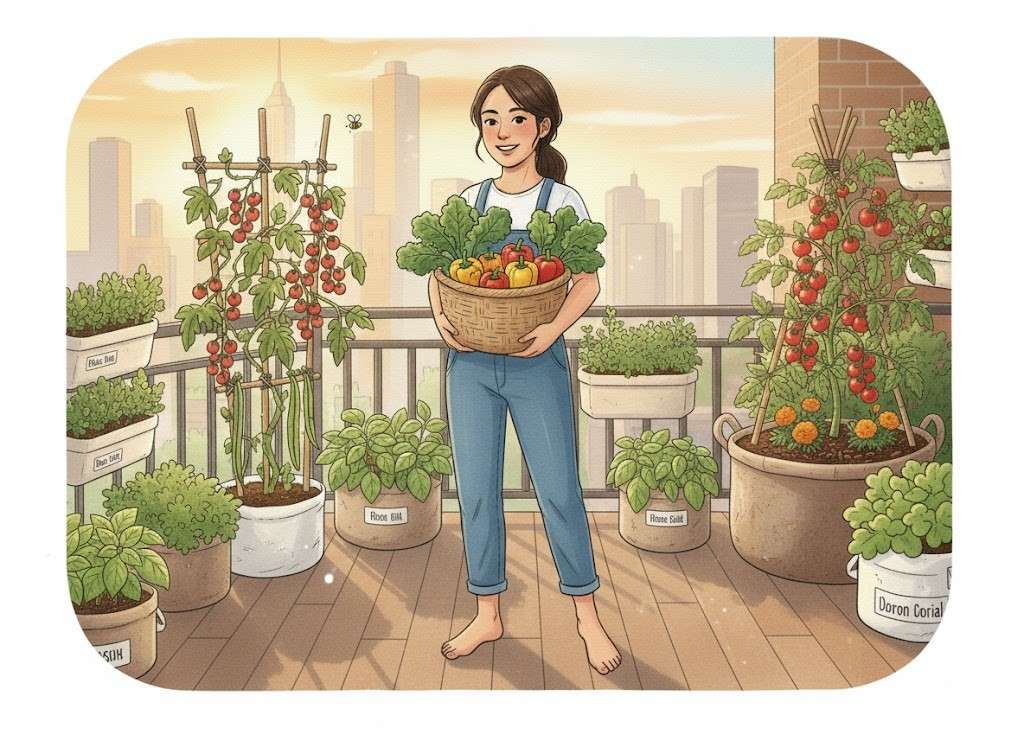Living in a condo, apartment, or tiny urban home doesn’t mean you have to give up on the joy of fresh, homegrown, organic produce. “Organic Gardening in Small Spaces” is the smart, sustainable movement that uses ingenious techniques to maximize every single square inch without relying on synthetic chemicals.
This comprehensive guide, updated with insights from 2025 urban gardening research, provides step-by-step advice to help you create a vibrant, thriving mini-garden on your balcony, patio, windowsill, or indoors. Expect practical tips that will allow you to grow healthier plants, save 20-30% on herbs and specialty veggies, and boost your mental well-being through the calming effects of hands-on gardening.
Let’s turn your limited space into a productive green oasis.
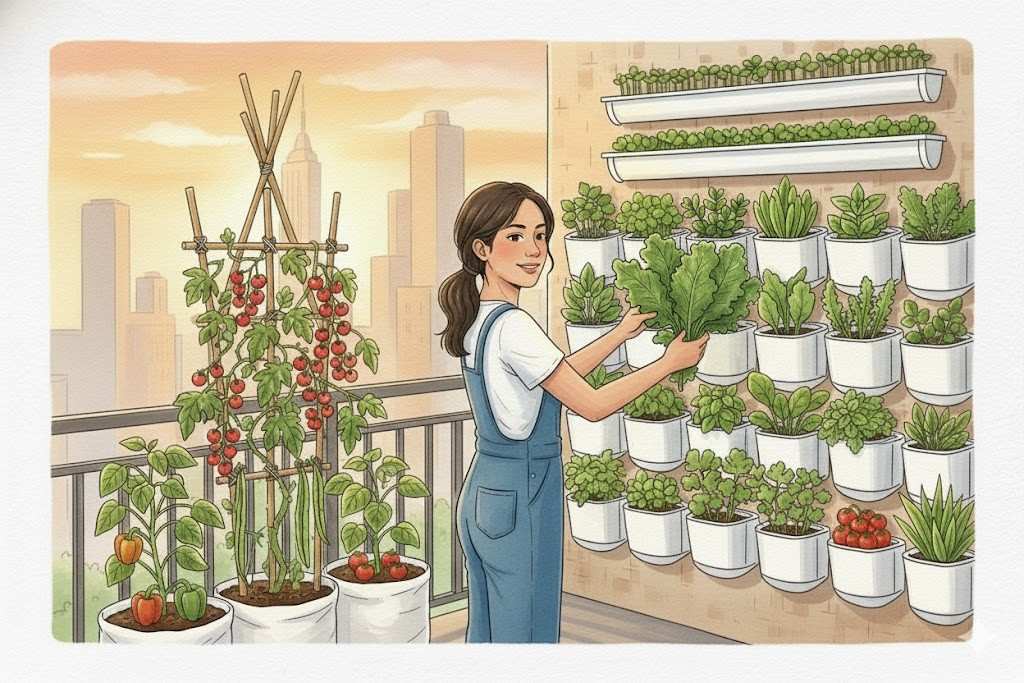
Why Choose Organic Gardening for Urban Spaces?
Organic gardening prioritizes natural processes—no synthetic pesticides or fertilizers—to build healthy soil and resilient plants. This approach is ideal for compact urban settings due to its efficiency and eco-friendliness.
| Key Benefit | Quick Explanation |
| Space Maximization | Vertical gardening and container stacking can triple your planting area without needing more floor space. |
| Health and Savings | Grow nutrient-dense, chemical-free food; small plots can yield 4-6 pounds per square foot annually, significantly cutting your grocery bill. |
| Eco-Friendly | Composting kitchen scraps diverts up to 30% of household waste from landfills and supports essential pollinators like bees, creating a mini-ecosystem. |
| Total Control | Containers and raised beds allow you to overcome urban challenges like poor or contaminated soil and limited sunlight, giving you full control over growing conditions. |
Expert Insight: According to Mother Earth News, small-space organic methods can rival the productivity of larger backyard gardens, especially when utilizing vertical and container techniques. For optimal non-ground planting, check our review on the Top-Rated Raised Garden Beds that fit well in tight spaces.
Phase 1: Assessing Your Small Space
Start with a simple site survey. Matching your techniques to your specific location is crucial for avoiding beginner mistakes, like planting sun-loving tomatoes in a shady corner.
1. Sunlight Levels: The Golden Rule
- Most vegetables need 6-8 hours of direct sunlight daily.
- How to Check: Track sunlight over a few days using a phone app like Sun Seeker.
- Planting Strategy:
- South-Facing Balconies: Ideal for high-sun crops like Tomatoes, Peppers, and Basil.
- North-Facing or Shady Spots: Perfect for low-light crops like Lettuce, Spinach, and Kale.
- Low-Light Solutions: Invest in affordable LED grow lights (Full Spectrum, about 20W per shelf) and run them for 12-14 hours daily indoors.
2. Wind, Weight, and Microclimate
- Wind: Urban balconies can be extremely windy. Use sturdy trellises or screens as windbreaks.
- Weight: Always account for the weight of your pots and soil (soil weighs 50-100 lbs per cubic foot). Crucially, check your building’s weight limits, especially for high-rise balconies.
- Soil Baseline: If you don’t have access to in-ground soil, use a quality organic potting mix. Test the pH (6.0-7.0) if necessary with an inexpensive kit. Always use containers if urban soil contamination is a concern.
Pro Tip: Sketch out your layout using graph paper or a simple app like Garden Planner to prevent overcrowding and optimize companion planting (e.g., placing basil near your tomatoes to naturally deter pests).
Phase 2: Essential Tools and Materials for Beginners
You need minimal, budget-friendly tools to start. Here is a starter kit tailored for organic small-space gardening.
| Item | Purpose | Usage Tips for Small Spaces |
| Containers (Fabric or Terracotta) | Holds soil and plants; fabric promotes “air-pruning” for healthier roots. | Use 5-10 gallon pots for veggies, 1-2 gallons for herbs. Drill extra drainage holes to prevent root rot. |
| Peat-Free Potting Mix (Coco Coir-Based) | Nutrient-rich base; more sustainable than peat. | Mix 1/3 compost, 1/3 coco coir, 1/3 perlite for aeration and drainage. |
| Heirloom Seeds/Seedlings | Non-GMO, trusted source for organic starts. | Start seeds indoors in egg cartons to save money; transplant when 2-3 inches tall. |
| Watering Can or Drip System | Efficient watering; critical for container gardens. | Water deeply at soil level to avoid leaf diseases. Use a small drip system if you travel frequently. |
| Bamboo Trellis/Netting | Supports climbers for vertical gardening. | Install support early before vines become too heavy or damaged. |
| Vermicomposter or Bokashi | Recycles kitchen scraps into powerful fertilizer, odor-free for apartments. | Add food scraps weekly; worms convert it into rich “worm castings” fertilizer. |
Phase 3: High-Yield Organic Gardening Techniques
Once your space is assessed and tools are ready, these four techniques will ensure a successful, high-yielding harvest.
Technique 1: Container Gardening Mastery
Containers are the foundation of small-space organics—they are portable, customizable, and beginner-friendly.
Container Prep and Soil Mix
- Clean: Sanitize old pots with a 1:1 vinegar-water solution.
- Drainage: Add about 1-inch of gravel or pottery shards to the bottom to improve drainage.
- Soil Blend: Use a robust, custom mix: 40% high-quality compost (for nutrients), 30% coco coir (for moisture retention), and 30% perlite (for airflow).
Maintenance and Grouping
- Grouping: Place plants with similar light and water needs together. Tomatoes and basil are great companions.
- Watering: Check the soil 2 inches deep daily. Water deeply if dry. Avoid overwatering—let the topsoil dry slightly to encourage deep root growth.
- Fertilizing: Apply an organic liquid feed, such as a fish emulsion (diluted $1:10$), bi-weekly to prevent nutrient burn and deficiencies.
Yields: A single 10-gallon pot can produce 10-15 lbs of tomatoes per season, according to 2025 urban gardening data.
Technique 2: Vertical Gardening for Maximum Density
Vertical gardening is the most efficient way to use limited wall space, potentially tripling your growing area.
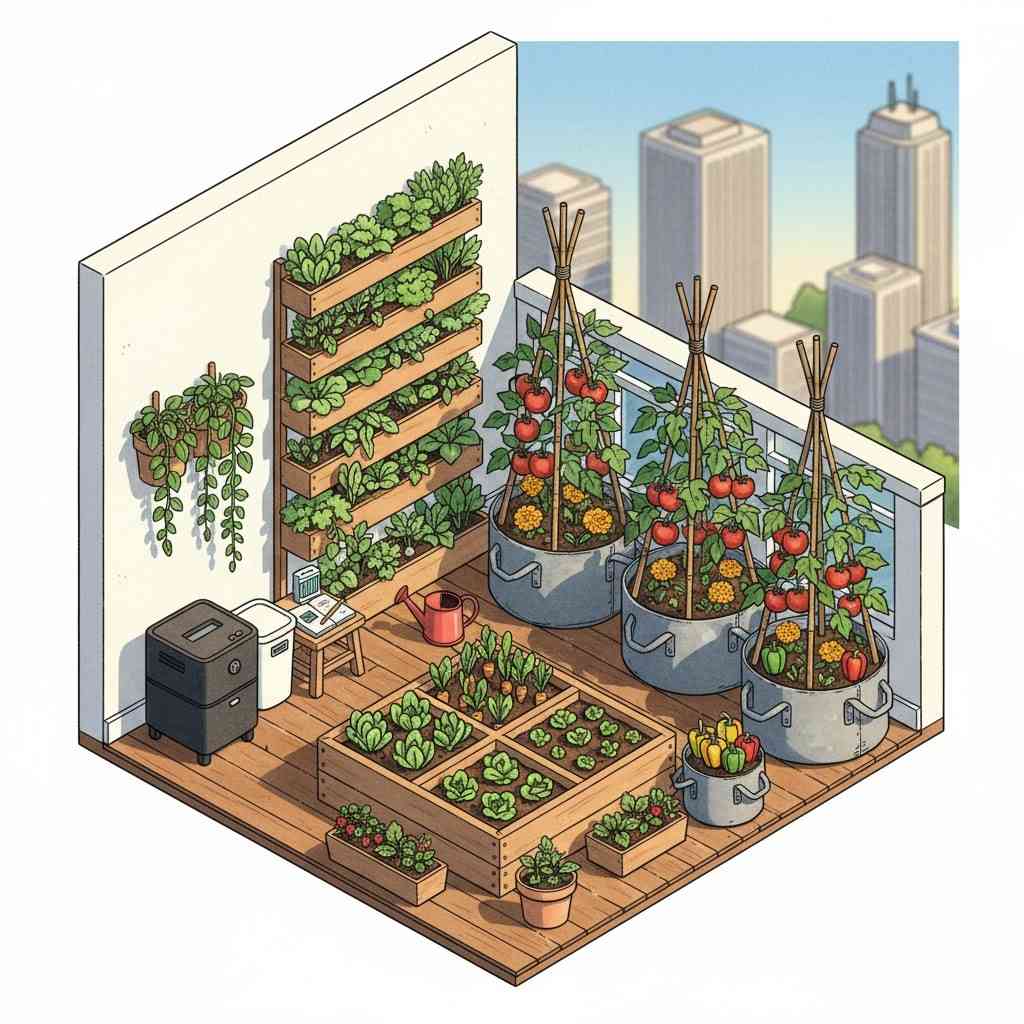
DIY Vertical Systems
- Wall Pockets: Hang fabric pockets ($15/set) on balcony walls for growing greens (lettuce, spinach). They are lightweight and easy to manage.
- Trellises: Build simple bamboo frames for climbers like pole beans (high yield) or cucumbers. Secure them firmly to the railing or wall. For commercial options, refer to our review of the Top 5 Tomato Cages that work in containers.
- Recycled Gutters: Mount plastic rain gutters for quick-harvest crops like microgreens—remember to drill drainage holes!
Planting Tips
- Use a lightweight potting mix—ideally 40% coco coir, 30% compost, and 30% perlite. This blend is crucial for minimizing the stress and weight on the vertical mounting structure.
- Water from the top-down to ensure even distribution to all plants.
- Tip: Anchor systems with guide wires in windy areas to prevent damage.
Technique 3: Succession Planting and Crop Rotation
Keep your garden productive year-round with strategic planting schedules—essential for maximizing small-space output by up to 50%.
- Succession Planting: Sow a new batch of seeds every 2-3 weeks (e.g., radishes, lettuce) for continuous harvests. Extend the life of leafy greens by harvesting only the outer leaves.
- Crop Rotation: Swap plant families seasonally (e.g., move from “nightshades” like tomatoes/peppers to “legumes” like peas/beans). This prevents soil depletion and pest buildup.
| 2025 Seasonal Planting Guide | Crops to Focus On | Tips |
| Spring (March–May) | Cool crops: Peas, Kale, Carrots | Start indoors if late frost is a risk. Refresh soil with compost. |
| Summer (June–August) | Heat lovers: Tomatoes, Peppers, Basil | Use a shade cloth in extreme heat. Water heavily at dawn. |
| Fall (September–November) | Roots: Beets, Carrots, Garlic | Apply a layer of straw mulch for insulation. |
| Winter (Dec–Feb) | Indoors: Herbs, Microgreens | Use LED lights for 12-14 hours per day. |
Technique 4: Organic Pest and Disease Control
Natural, non-chemical methods keep your small garden healthy and manageable.
Prevention Strategies
- Companions: Plant marigolds with tomatoes to repel root-eating nematodes. Basil near peppers deters flies.
- Airflow: Space plants 4-6 inches apart and prune weekly to reduce humidity—the primary cause of fungal diseases in urban gardens. For detailed guidance on shaping your plants, see our guide on Pruning Tomato Plants for Beginners.
- Soil Health: Add mycorrhizal fungi (available in packets) to boost root strength and resilience against pests.
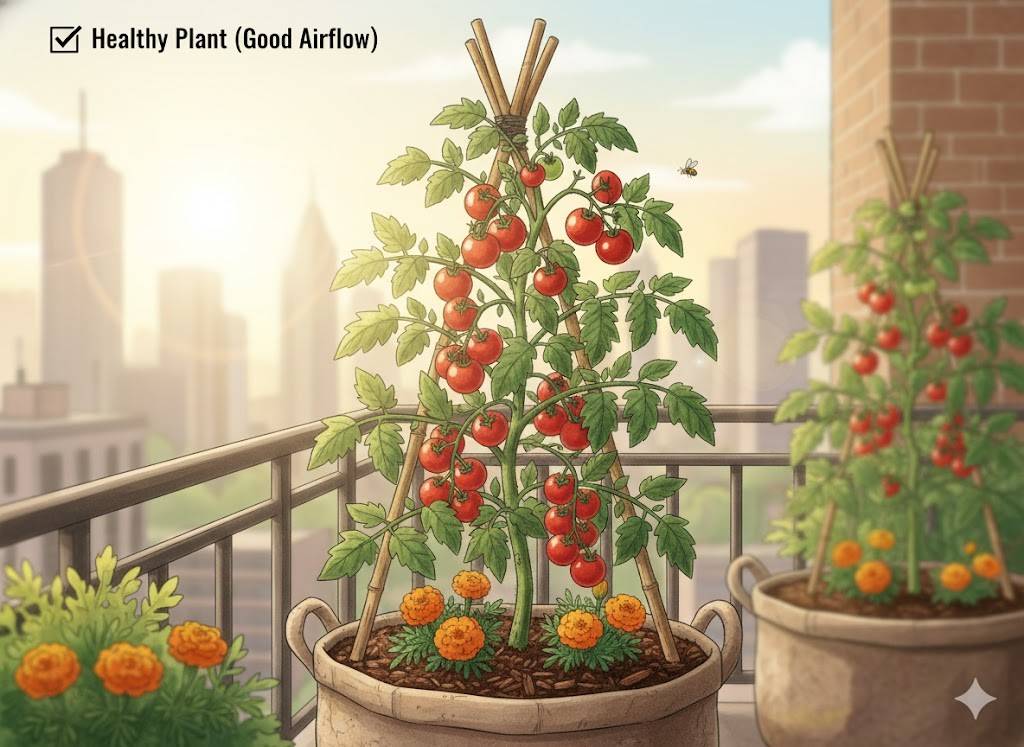
Natural Remedies
- Neem Spray: Mix 1 tsp neem oil + 1 quart water + a drop of dish soap. Spray thoroughly at dusk to avoid harming pollinators. Effective against aphids and spider mites.
- Diatomaceous Earth (DE): Dust around pot bases for slugs and ants. Reapply after rain.
- Hand Removal: Pick off visible pests (like hornworms) early in the morning and drop them into soapy water.
Phase 4: Composting in Tight Quarters (Odor-Free)
Composting recycles valuable nutrients back into your garden and addresses up to 30% of your household waste stream.
Apartment-Friendly Methods
- Vermicomposting (Worm Bins):
- Use small bins (under-sink size). Red Wiggler worms process about 1 lb of scraps per week.
- Mix shredded paper or coco coir for bedding. Odor-free if balanced correctly.
- Bokashi:
- Ferment food scraps (even meat and dairy!) in airtight buckets with a special bran inoculant.
- The process takes 2 weeks and is odorless. The fermented scraps can then be buried or used to create “compost tea.”
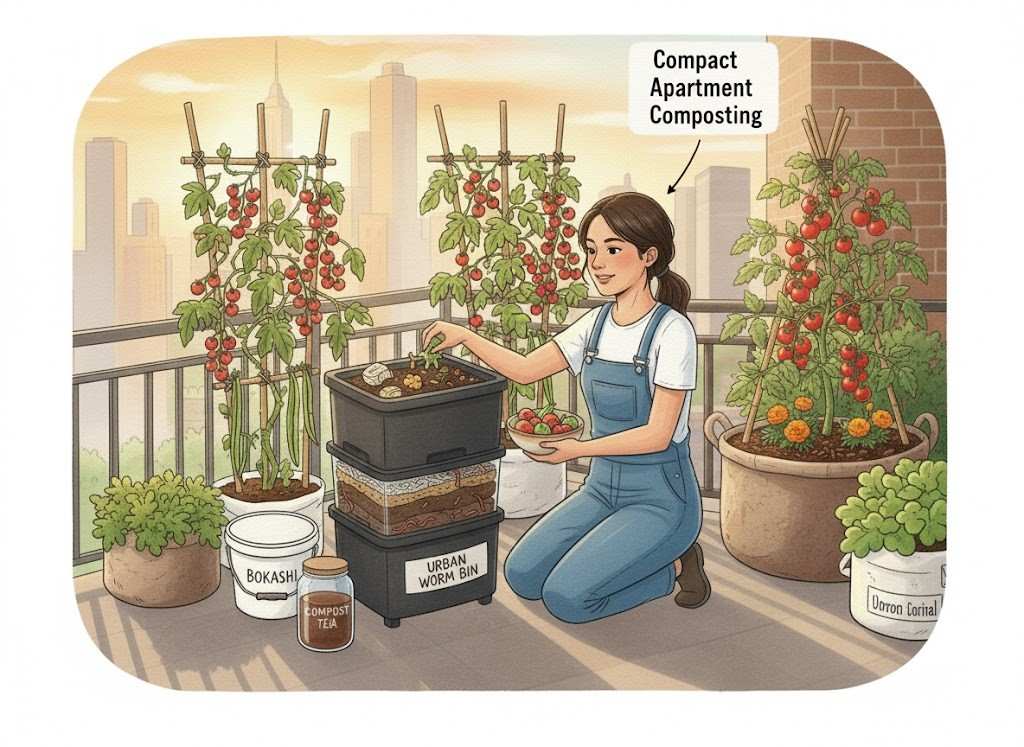
Composting Basics: Maintain a 2:1 ratio of browns (shredded cardboard, dry leaves) to greens (fruit/veggie peels, coffee grounds) for optimal, odor-free decomposition.
Recommended Plants for a Small Organic Garden
Choose compact, high-yield varieties that perform well in containers or vertical setups.
| Plant | Space & Yield (Container Size) | Tips for Success |
| Cherry Tomatoes | 5-gal pot, 10-20 lbs/season | Stake aggressively; prune suckers. Full sun is essential. |
| Lettuce | Shallow tray, continuous harvest | Succession sow every 2 weeks. Provide light shade in peak summer. |
| Basil | 1-gal pot, 2-3 lbs/season | Pinch tops often to encourage bushy growth. Perfect companion for tomatoes. |
| Radishes | 6-inch pot, 20-30 roots in 3 weeks | The fastest crop! Thin seedlings early to prevent crowding. |
| Strawberries | Hanging basket, 1-2 lbs/season | Choose everbearing varieties. Use netting against birds. |
| Kale | 2-gal pot, 5 lbs/season | Harvest only the outer leaves to extend the plant’s life. Cold-tolerant. |
| Peppers | 3-gal pot, 10-15 fruits/season | Full sun required. Apply mulch to retain moisture. |
Recommendation: Start with just 3-5 crops you love to eat. Herbs (Basil, Mint, Parsley) are excellent for beginners due to their low space requirements.
Troubleshooting & FAQs for Small-Space Gardeners
Common Troubleshooting
- Wilting: Usually underwatering or the plant is root-bound. Add mulch or repot into a larger container.
- Yellow Leaves: Most often a sign of nutrient deficiency (feed with compost tea) or overwatering (check drainage).
- Slow Growth: Insufficient light. Use a reflector or install grow lights to boost light intensity by 10-20%.
Frequently Asked Questions
| Question | Answer |
| Can I garden indoors year-round? | Yes! Use a south-facing window or full-spectrum LEDs for 14 hours; focus on greens and herbs. |
| How do I prevent balcony leaks? | Always place saucers/trays under pots. Use specialized plastic liners or “leaky-proof” trays to catch drips. |
| What’s the quickest crop to harvest? | Radishes—seed to salad in about 25 days, perfect for immediate gratification. |
| What about composting odors? | A balanced mix of browns/greens, or using the Bokashi method, eliminates odors in apartments. |
Conclusion
Organic gardening in small spaces is empowering and accessible. Start with simple assessments, containers, and basic composting, then scale up with vertical systems and succession planting. With these clear techniques, even a tiny balcony can yield a bountiful, chemical-free harvest. Experiment, observe, and enjoy the process—each season will hone your green thumb! Happy growing.
